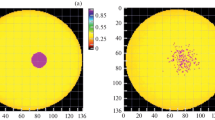Abstract
The intensity of radiation backscattering in the near infrared range is calculated for the bilayer model of a strongly heterogeneous medium that can be treated as the system of “skull–brain” biological tissues. The Monte Carlo simulation procedure for multiple scattering in a bilayer randomly heterogeneous system is described based on the Bethe–Salpeter equation. As the single-scattering indicatrix, the Henyey–Greenstein phase function is used. The dependences of the backscattering intensity on the distance along the head surface between the radiation source and the detector are calculated. The form of these dependences turns out to be sensitive to the change of system parameters such as the scattering indicatrix anisotropy, the layer thickness, and the laser radiation wavelength. This feature can be used in medical diagnostics. An alternative approach is proposed to the calculation of the probability density distribution for the photon free path length. It is shown that beginning from the source–detector distance on the order of several transport lengths, the calculated intensity is in good agreement with the predictions of the diffusion theory.




Similar content being viewed by others
REFERENCES
S. L. Jacques, Phys. Med. Biol. 58, R37 (2013).
D. J. Davies, Z. Su, M. T. Clancy, et al., J. Neurotrauma 32, 933 (2015).
V. V. Tuchin, Tissue Optics: Light Scattering Methods and Instruments for Medical Diagnostic (IPR Media, Moscow, 2021; SPIE Press, 2015).
A. N. Bashkatov, A. V. Priezzhev, and V. V. Tuchin, Quantum Electron. 41, 283 (2011).
D. K. Joseph, T. J. Huppert, M. A. Franceschini, and D. A. Boas, Appl. Opt. 45, 8142 (2006).
M. Dehaes, P. E. Grant, D. D. Sliva, et al., Biomed. Opt. Express 2, 552 (2011).
J. Selb, D. A. Boas, S.-T. Chan, et al., Neurophoton. 1, 015005 (2014).
A. Sabeeh and V. V. Tuchin, J. Biomed. Photon. Eng. 6, 040201 (2020).
R. Francis, B. Khan, G. Alexandrakis, et al., Biomed. Opt. Express 6, 3256 (2015).
S. Mamani, L. Shi, T. Ahmed, et al., J. Biophotonics 11, e201800096 (2018).
A. P. Tran, S. Yan, and Q. Fang, Neurophoton. 7, 015008 (2020).
E. Zinchenko, N. Navolokin, A. Shirokov, et al., Biomed. Opt. Express 10, 4003 (2019).
E. S. Papazoglou, M. D. Weingarten, S. Michael, et al., J. Biomed. Opt. 13, 044005 (2008).
E. S. Papazoglou, M. T. Neidrauer, L. Zubkov, et al., J. Biomed. Opt. 14, 064032 (2009).
S. Mahmoodkalayeh, M. A. Ansari, and V. V. Tuchin, Biomed. Opt. Express 10, 2795 (2019).
M. S. Cano-Velazquez, N. Davoodzadeh, D. Halaney, et al., Biomed. Opt. Express 10, 3369 (2019).
A. Kienle, M. S. Patterson, N. Dögnitz, et al., Appl. Opt. 37, 779 (1998).
J. H. Choi, W. Martin, V. Yu. Toronov, et al., J. Biomed. Opt. 9, 221 (2004).
M. A. Franceschini, S. Fantini, L. A. Paunescu, et al., Appl. Opt. 37, 7447 (1998).
L. Wang, S. L. Jacques, and L. Q. Zheng, Comput. Meth. Prog. Bio. 47, 131 (1995).
V. L. Kuzmin and A. Yu. Val’kov, JETP Lett. 105, 283 (2017).
V. L. Kuzmin, A. Yu. Val’kov, and L. A. Zubkov, J. Exp. Theor. Phys. 128, 396 (2019).
V. L. Kuzmin, V. P. Romanov, and E. V. Aksenova, Phys. Rev. E 65, 016601 (2001).
V. L. Kuzmin, M. T. Neidrauer, D. Diaz, et al., J. Biomed. Opt. 20, 105006 (2015).
L. Devroye, Non-Uniform Random Variate Generation (Springer, New York, 1986).
T. H. Pham, O. Coquoz, J. B. Fishkin, et al., Rev. Sci. Instrum. 71, 2500 (2000).
A. N. Bashkatov, E. A. Genina, V. I. Kochubey, et al., J. Phys. D: Appl. Phys. 38, 2543 (2005).
A. N. Bashkatov, E. A. Genina, V. I. Kochubey, et al., Proc. SPIE 6163, 616310 (2006).
J. D. Johansson, J. Biomed. Opt. 15, 0570059 (2010).
E. A. Genina, A. N. Bashkatov, D. K. Tuchina, et al., Biomed. Opt. Express 10, 5182 (2019).
T. Durduran, R. Choe, W. B. Baker, et al., Rep. Prog. Phys. 73, 076701 (2010).
T. M. Nieuwenhuizen and J. M. Luck, Phys. Rev. E 48, 569 (1993).
V. L. Kuzmin and A. Yu. Valkov, J. Quant. Spectrosc. Radiat. Transfer 272, 107760 (2021).
D. Tamborini, P. Farzam, B. B. Zimmermann, et al., Neurophoton. 5, 011015 (2017).
Author information
Authors and Affiliations
Corresponding authors
Ethics declarations
The authors declare that they have no conflicts of interest.
Additional information
Translated by N. Wadhwa
Rights and permissions
About this article
Cite this article
Kuzmin, V.L., Zhavoronkov, Y.A., Ul’yanov, S.V. et al. Simulation of Radiation Transfer in Terms of the Bethe–Salpeter Equation for Bilayer Biological Tissue Systems. J. Exp. Theor. Phys. 134, 661–668 (2022). https://doi.org/10.1134/S1063776122050090
Received:
Revised:
Accepted:
Published:
Issue Date:
DOI: https://doi.org/10.1134/S1063776122050090




